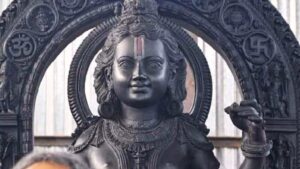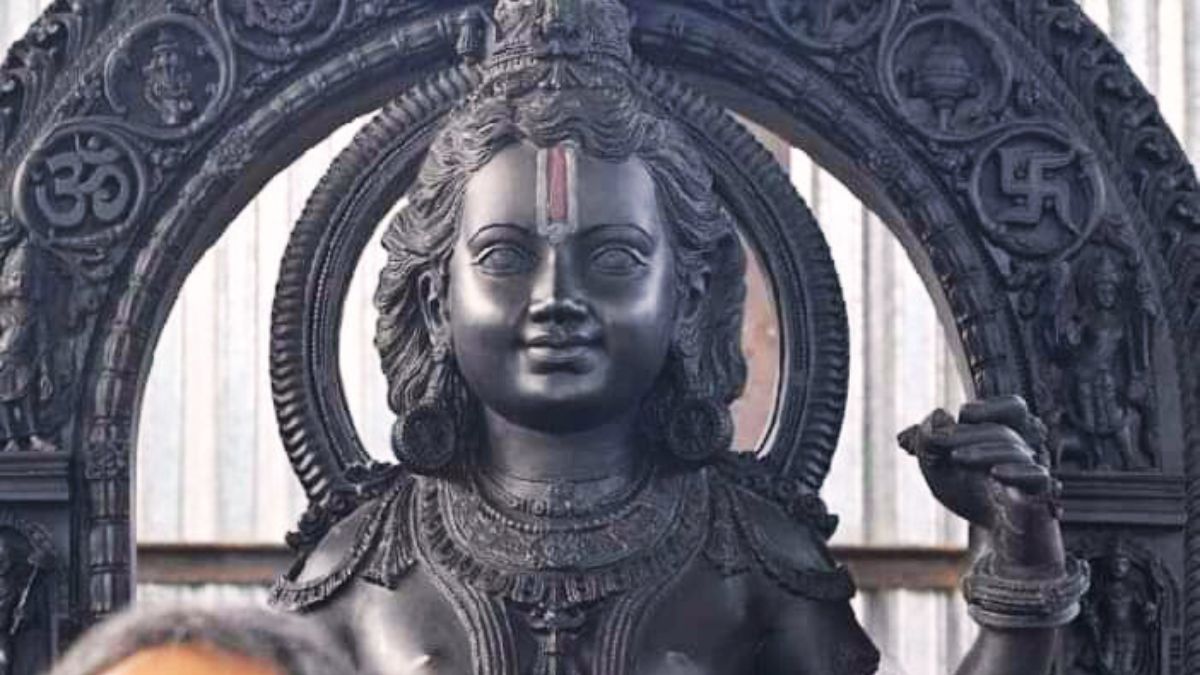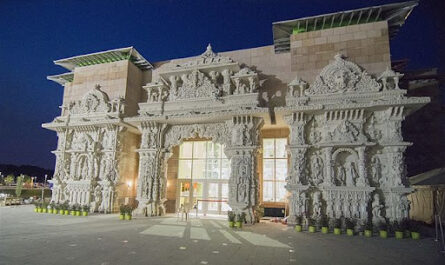Ahead of the scheduled opening of the Ram Temple on Monday, the countenance of the deity Ram Lalla has been unveiled. The sacred idol, measuring 51 inches in height and intricately crafted by Mysuru-based sculptor Arun Yogiraj, was transported to the temple during the early hours of Thursday as part of the pre-consecration rituals.

The installation of the Ram Lalla idol within the sanctum sanctorum took place on Thursday afternoon, as reported by Arun Dixit, a priest associated with the consecration ceremony, according to news agency PTI. The Shri Ram Janmbhoomi Teerth Kshetra Trust, responsible for overseeing the temple’s construction, highlighted the meticulous design of the idol in newly released photos on Friday.
The Trust revealed that the installation occurred amidst the reverent atmosphere of prayer. Udupi Pejawar mutt Sri Vishwaprasanna Teertha, a trustee of Shri Ram Janmabhoomi Teerth Kshetra Trust, disclosed that the formal installation, known as ‘pran pratishtha,’ is scheduled for the auspicious ‘Abhijith Muhurta’ on January 22, in the presence of Prime Minister Narendra Modi.
To ensure security, only invited guests will be permitted to enter the temple on the inaugural day. Following the ‘pran pratishtha’ ceremony on January 22, the Ram Temple is anticipated to open its doors to the public on the subsequent day. The unveiling of Ram Lalla’s face marks a significant moment in the lead-up to the temple’s consecration.
New Ram Lalla idol is installed, stage set for ‘hawan’ ritual
As part of the elaborate rituals leading up to the consecration ceremony of the Ram Temple, the 51-inch-tall idol of Ram Lalla, crafted by Arun Yogiraj, underwent the “Jaladhivas” and “Gandhadhivas” ceremonies. At precisely 1:28 pm on Thursday, deemed auspicious by the priests, the idol was installed in the sanctum sanctorum amidst the chanting of hymns. The ceremony was attended by key members of the Ram Janmabhoomi Teerth Kshetra Trust, including Anil Mishra, Champat Rai, and Swami Govind Giri.
Given the idol’s weight of 200 kg and the limited space in the sanctum sanctorum, a team of engineers supervised the installation. The idol underwent the “Jaladhivas” ritual, where it was draped with a wet cloth, followed by the “Gandhadhivas” ritual, where it was covered in a special paste made of Chandan and Kesar. Simultaneously, rituals commenced on the old idol, referred to as the “Rajat” or “Utsav” idol.
After installation, the sanctum was cleansed and covered with a curtain. Access to the sanctum is restricted, with only the Acharya and the “Yajman” permitted for a series of rituals, starting with Ganesh Ambika Pujan, Varun Pujan, and Vastu Pujan. The “mandap” was prepared for the upcoming “hawan,” which begins on Friday in preparation for the consecration on January 22.
To facilitate public participation in the celebrations, the Centre declared a half-day on January 22 for Central Government Offices, Central Institutions, and Central Industrial Establishments until 14:30 hours.
In Ayodhya, a priest explained the “Jaladhivas” ritual, mentioning that, ideally, the idol is submerged in river water. However, due to the idol’s size, a water urn is placed at its feet, and a cloth soaked in water is draped over it. The day concluded with the cleaning of the “special paste of chandan mixed with kesar” and an aarti at 7:30 pm.
The “hawan” is set to commence around 9 am on Friday at the mandap, located about 100 meters from the temple, and will continue until January 22. The fire from this ritual will be used to light the ‘nine kundas’ in the nine corners of the temple, which will remain lit 24X7.
In parallel, Prime Minister Narendra Modi released six special commemorative postage stamps dedicated to the temple and an album featuring stamps related to Lord Ram. The Prime Minister emphasized the timeless and universal teachings of Lord Ram, urging Cabinet ministers to celebrate the consecration like Diwali by lighting diyas at their homes and feeding the poor. Ministers were also encouraged to visit the temple with devotees from their respective states after January 22.


